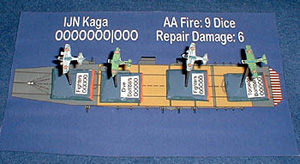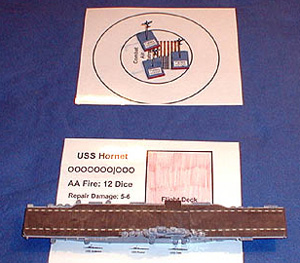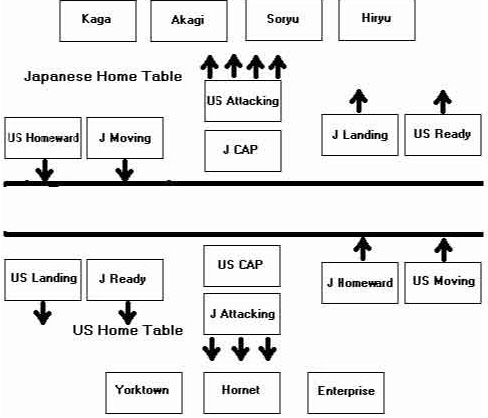 Version 2:
Version 2:
I made some changes to these rules. The original version can be found in The Volunteer. The main change made was to the sequence of play. The turns were subdivided to eliminate confusion created by having the kids try to do several different things at once. Fighter escort rules were also changed, and some notes about 1/700 and 1/1200 models were added. Improved carrier and plane counters were created. New battle reports and pictures are included.
Background:
The Japanese hoped that World War II would make them the masters of the Pacific. They recognized the industrial might of the United States. Their strategy was therefore to destroy the American Navy with a surprise attack on Pearl Harbor. The plan almost worked. The Japanese ran wild in the Pacific and seemed invincible. The most devastating weapons in their navy were their aircraft carriers. In 1942 the Americans had been driven from the Philipines and Australia was in peril. The next step in their campaign was to seize control of the American controlled island of Midway. The Japanese admiral, Yamamoto, also hoped the attack would bring the remnants of the American Navy out to fight so that he could finish it off.
The Americans had different ideas. They had cracked the Japanese code and were routinely reading their secret messages. They uncovered the Japanese plan to attack Midway and decided to gamble everything on ambushing the Japanese carriers. The Yorktown was rapidly repaired and sent to join the Enterprise and Hornet. The Japanese air strike hit Midway Island hard. But then the Americans located the enemy carriers and attacked. The shocked Japanese retaliated but lost all four of their carriers. Pearl Harbor had been avenged (The Japanese carriers had participated in the surprise attack). The Americans lost just one carrier, the Yorktown. In one battle the tide of the war in the Pacific had turned.
The Japanese would never regain the initiative. Yamamoto had once said that he was afraid that the United States was a sleeping giant, which would awaken with a terrible resolve. He was right.
Battle 1:
The first wave of American bombers caught the Japanese by surprise. Dive bombers from the Yorktown devastated the Soryu, leaving her burning out of control as her crew abandoned ship. The Hiryu was also crippled in the attack, and the Kaga and Akagi suffered minor damage. The Japanese retaliatory strike destroyed the Yorktown, and damaged the Hornet. The Japanese put up a powerful fighter umbrella over their carriers and launched a second strike of their own. When the American second strike reached the Japanese fleet they were without fighter protection, and the Japanese zeroes chewed them to pieces. The surviving bombers bravely attacked the Japanese flattops, finishing off the Hiryu and crippling the Akagi.
The powerful Kaga, however, was still operational. The Japanese second attack wave was more successful. Their bombers concentrated on the Enterprise, overwhelming her air defenses. Kate torpedo bombers scored a series of direct hits, sinking the Enterprise. and leaving the Hornet a burning wreck. Another wave of Japanese bombers soon arrived, courtesy of the Kaga. They bravely flew through heavy anti-aircraft fire to deliver the knock out to the Hornet. The Japanese had succeeded in destroying the American carriers, although at a higher cost than they'd expected.
 Battle 2:
Battle 2:
This battle was closely fought, with the two fleets trading blows and the outcome in doubt until the very end. The Americans struck first, crippling the Soryu with their Dauntless dive bombers. The Japanese quickly scrambled an effective fighter cover and struck back, crippling the Hornet. The Americans retaliated, first crippling the Akagi, then sinking her along with the Soryu. The next wave of Japanese bombers finished off the Hornet, and destroyed the Enterprise. The Americans had one more strong attack wave left, and it scored big, sinking the Akagi and leaving the Kaga badly damaged. The Japanese counterpunch was a glancing blow, inflicting minor damage on the Yorktown. Both sides put everything they had left into a final strike.
The Americans arrived first, just as the Kaga launched her bombers. The Japanese pilots watched in horror as the American bombs scored direct hits on the Kaga, forcing her crew to abandon ship. The pilots knew that their attack would be a one-way trip since there would be no Japanese carriers for them to land on after their attack run. They now had only one thought in mind: sink the Yorktown! The Yorktown went into evasive maneuvers as Kate torpedo bombers and Val dive bombers attacked her with a desperate fury. Miraculously, only one bomb hit the Yorktown. For a moment it looked like that would be enough to finish off the ship, but soon her crew had managed to put out the fires and save the ship. The Yorktown limped back to port for repairs, keeping a watchful eye out for enemy submarines. This battle was an American victory.
Models:
I used 1/700 scale waterline ship models for this battle. Hasegawa makes models of the Kaga, and Akagi. They also have a Yorktown model, but this is the Yorktown II, not the one that was sunk at Midway. Tamiya has models of the Hornet and Enterprise. Aoshima makes models Models of the Hiryu and Soryu. These model kits are rather expensive, and not easy to build. Yorktown II comes with 20 planes, Kaga and AKagi have 28 planes each (including 12 seaplanes), additional 1/700 planes are available from Hasegawa's US Naval Planes and Japanese Naval Planes sets. The sets include fighters, dive bombers, and torpedo bombers, but not the right ones for Midway. But seriously, at 1/700 scale does it really matter? These ship model kits are rather expensive ($15-$35), and not easy to build. A cheaper alternative is to use 1/1200 scale Revell Miniships. These models are cheap, and the kids can put them together with ease, despite the poor instructions. Unfortunately they only make models for the Hornet and Enterprise. Each has 19 generic looking planes, and Hornet also has 16 bombers for Doolittle's Raid. I have created paper plane and carrier counters you can print and use instead. I actually prefer the paper planes over the 1/700 plastic planes.
Basing:
One plane model was used to represent a group of fighters or bombers. The Ship Data table indicates how many planes you'll need for each carrier. The planes were glued to nails so they would look like they were flying. The bases were 1.5" x 1" pieces of foam core. Each base was painted blue and labeled with its type (fighter, torpedo bomber, dive bomber) and five circles to represent the strength of the group. The labels were laminated so they could be marked with dry erase markers. Each base was also color coded to indicate its carrier. The nail was pressed into the center of the foam core base. The foam core will hold the nail firmly, and doesn't need to be glued. This allows you to remove the plane from the base for easy storage. If this basing method seems too elaborate you should check out the original version of these rules, which included simple flat black & white table top counters which are easy to print and use. The carriers don't need bases, but you should label them with their names, AA Fire, Repair Damage, and Damage Points from the Ship Data Table. This information can be written on index cards, or the paper carriers can be printed and used.
Ship Data
| Carrier |
|
|
|
|
|
| Enterprise |
|
|
|
|
|
| Hornet |
|
|
|
|
|
| Yorktown |
|
|
|
|
|
| Hiryu |
|
|
|
|
|
| Soryu |
|
|
|
|
|
| Akagi |
|
|
|
|
|
| Kaga |
|
|
|
|
|
| Each carrier is crippled when it has 7 damage points, and sinks at 10 damage points | |||||
 Set Up:
Set Up:
Two gaming tables are needed. They should be some distance apart and covered in blue felt, if possible. One table will hold the Japanese fleet, the other will hold the American fleet. Print out the Japanese boxes and American boxes , or simply write their names on pieces of paper. The various boxes should be laid out as illustrated. Eight bombers from each Japanese carrier should be placed in their "Ready to Land" box. This is the first wave returning from the attack on Midway Island. They must be landed before new planes can be launched.
Useful Resources:
"Pacific Carrier Strike" by Mike Crane, Lone Warrior #144, scenario for one or two players
"Midway" Warp Spawn Games (http://www.angelfire.com/games2/warpspawn/HistoricalGames.html) warning: many irritating pop-up ads at this side
Nihon Kaigun (Imperial Japanese Navy) web site.www.combinedfleet.com
Department of Navy's Navy Historical Center: www.history.navy.mil/index.html
Tom Gallagher provided useful suggestions during the development of this game
A Terrible Resolve Midway Version 2
- Historical Background and Set Up
Fast Play Rules for Students
Aircraft Carriers
Aircraft
Administrative Sheets
Back to Table of Contents -- Junior General Report # 5
Back to Junior General Report List of Issues
Back to MagWeb.com Magazine List
© Copyright 2004 by Matt Fritz.
This article appears in MagWeb.com (Magazine Web) on the Internet World Wide Web. Other articles covering military history and related topics are available at http://www.magweb.com